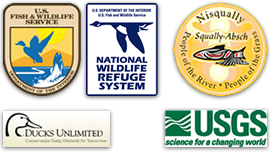Links
Nisqually Restoration and Monitoring Partners
Nisqually National Wildlife Refuge is managed by the U. S. Fish and Wildlife Service and is managing the Nisqually NWR restoration work.
Ducks Unlimited is a key partner in the restoration, providing plannning and technical assistance, engineering, funding, and contracting services for the restoration.
Nisqually Indian Tribe is a key partner in the restoration, providing technical and design assistance and is conducting estuary restoration on tribal lands within the Nisqually NWR boundary and fish monitoring studies in support of the project.
Tidal Marsh Monitoring is an online monitoring handbook for tidal marsh restoration practitioners.
Washington Department of Fish and Wildlife is a partner in the restoration, administering the Estuary and Salmon Restoration Program which is providing grant funding, assisting with amphibian monitoring, and is a landowner adjacent to the restoration site.
U.S. Geological Survey Western Ecological Research Center is the lead on science and monitoring for the restoration.
U.S. Geological Survey Western Fisheries Research Center is a research collaborator on Chinook life history in Puget Sound through otolith analysis.
U.S. Geological Survey Pacific Science Center is a research collaborator on nearshore environments in Puget Sound.
Nisqually River Groups and Organizations
Nisqually River Council is a “coordination, advocacy and educational organization” that implements the Nisqually River Management Plan and includes the key partners working to protect and restore the Nisqually River watershed.
Nisqually Land Trust acquires land to protect the Nisqually River watershed and its wildlife.
Nisqually Reach Nature Center is a nonprofit organization dedicated to educating school children on estuarine environments and has assisted on bird and invertebrate monitoring.
Nisqually River Council works to create sustainability in the Nisqually Watershed for current and future generations by developing a common culture of environmental, social, and economic balance.
Stewardship Partners has a program engaging local stakeholders in the protection of the Nisqually watershed.
Puget Sound Groups and Organizations
Coastal Habitats in Puget Sound (CHIPS) is an interdisciplinary collaboration to coordinate, conduct and integrate USGS studies of nearshore processes and coastal habitats. CHIPS works with federal, tribal, state, local entities, NGOs, and academia to identify science needs and conduct studies of physical, chemical, and biological processes to improve our understanding and ability to predict how land use including habitat restoration influences the nearshore environment. Information is shared through databases, geospatial models and analyses, technical reports, and formal publications.
Puget Sound Partnership is a community effort of citizens, governments, tribes, scientists and businesses working toether to restore and protect Puget Sound and charged by the State to recover Puget Sound.
Puget Sound Nearshore Partnership is a collaboration between the U.S. Corps of Engineers, state, local, and federal agencies, tribes, industries, and environmental organizations to identify significant ecosystem problems, evaluate potential solutions, and restore and preserve critical nearshore habitat. They provide support to the Estuary and Salmon Restoration Program in coordination with WDFW.
South Puget Sound Salmon Enhancement Group is a nonprofit organization working to protect and restore salmon and their habitat.
People for Puget Sound is driven by a vision of a clean and healthy Sound, teeming with fish and wildlife, cared for by people who live there.
Alliance for Puget Sound Shorelines is a partnership formed by the People for Puget Sound, the Trust for Public Land, and The Nature Conservancy for the protection and restoration of Puget Sound shorelines.
Other Organizations
eBird Online Bird Observation Data for Nisqually NWR A real-time, online checklist program, eBird has revolutionized the way that the birding community reports and accesses information about birds. Launched in 2002 by the Cornell Lab of Ornithology and National Audubon Society, eBird provides rich data sources for basic information on bird abundance and distribution at a variety of spatial and temporal scales.
The Washington State Recreation and Conservation Office supports salmon recovery by funding habitat protection and restoration projects and administers the Salmon Recovery Funding Board and Puget Sound Acquisition and Restoration programs, both of which provided grant funding for this project. It also supports related programs and activities that produce sustainable and measurable benefits for fish and their habitat.
Salmon Recovery Funding Board supports salmon recovery by funding habitat protection and restoration projects. It also supports related programs and activities that produce sustainable and measurable benefits for fish and their habitat.
National Oceanic and Atmospheric Administration (NOAA) endeavors to understand and predict changes in Earth’s environment and conserve and manage coastal and marine resources to meet our Nation’s economic, social, and environmental needs.
U.S. Environmental Protection Agency (EPA) leads the nation's environmental science, research, education and assessment efforts. The mission of the Environmental Protection Agency is to protect human health and the environment. Since 1970, EPA has been working for a cleaner, healthier environment for the American people.
